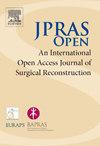颞肌神经支配的变异和分布:解剖学研究的系统回顾和荟萃分析。
IF 1.5
Q3 SURGERY
引用次数: 0
摘要
背景:尽管关于颞肌用于面部再生的广泛论述,但关于其运动神经分支的神经支配的解剖学描述是不完整和多样的。本系统综述旨在巩固有关颞肌神经支配的分布和变异的现有证据。方法:于2023年11月进行了符合prisma标准的系统文献检索,包括对颞肌神经支配模式的分布和变化提供解剖学见解的研究。进行多类别患病率及比例meta分析。结果:初步检索得到978个结果,从中选择13个研究纳入。颞下前肌区受颊神经上支支配,下后肌区受咬肌神经支配。在上部,包括前、中、后区域,神经支配由颞深神经(DTN)的分支提供,这些分支来自于下颌或咬肌神经的各个分支。分析显示,DTN最常见的变异是存在两个分支(46%,95% CI: 46%-63%, I2=94%),其次是三个分支(26%,95% CI: 24%-39%)。86例患者的亚组分析显示,颊神经颞支(85%,95% CI: 76%-92%, I2=98%)和咬肌神经颞支(72%,95% CI: 63%-81%, I2=90%)的神经支配率较高。结论:总之,本系统综述和荟萃分析强调了颞肌神经支配的不断发展的认识和复杂性,揭示了神经分支的变化,并强调了进一步研究的必要性。本文章由计算机程序翻译,如有差异,请以英文原文为准。
Variation and distribution in temporalis muscle innervation: A systematic review and meta-analysis of anatomical studies
Background
Despite extensive discourse on the utilisation of the temporal muscle for facial reanimation, anatomical description regarding the innervation of its motor nerve branches is incomplete and varied. This systematic review aimed to consolidate the existing evidence concerning the distribution and variation in the pattern of temporalis innervation.
Methods
A PRISMA-compliant systematic literature search was conducted in November 2023 and included studies offering anatomical insights into the distribution and variation of temporalis innervation patterns. Multiple category prevalence and proportional meta-analysis were conducted.
Results
The initial search yielded 978 results, from which 13 studies were selected for inclusion. The inferior anterior temporalis muscle region was found to receive innervation from the buccal nerve's superior branch and inferior posterior region from the masseteric nerve. In the superior part, comprising anterior, middle and posterior regions, innervation is provided by the branches of the deep temporal nerve (DTN) arising from various branches of the mandibular or masseteric nerves. Analysis revealed that the most common variation of DTN was the presence of two branches (46%, 95% CI: 46%-63%, I2=94%), followed by three branches (26%, 95% CI: 24%-39%). Subgroup analyses of 86 patients indicated high prevalence rates of innervation by the temporal branches of the buccal nerve (85%, 95% CI: 76%-92%, I2=98%) and temporal branches of the masseteric nerve (72%, 95% CI: 63%-81%, I2=90%).
Conclusion
In conclusion, this systematic review and meta-analysis highlight the evolving understanding and complexities of temporalis innervation, revealing the variations in nerve branches and emphasising the need for further research.
求助全文
通过发布文献求助,成功后即可免费获取论文全文。
去求助
来源期刊

JPRAS Open
Medicine-Surgery
CiteScore
1.60
自引率
0.00%
发文量
89
审稿时长
22 weeks
期刊介绍:
JPRAS Open is an international, open access journal dedicated to publishing case reports, short communications, and full-length articles. JPRAS Open will provide the most current source of information and references in plastic, reconstructive & aesthetic surgery. The Journal is based on the continued need to improve surgical care by providing highlights in general reconstructive surgery; cleft lip, palate and craniofacial surgery; head and neck surgery; skin cancer; breast surgery; hand surgery; lower limb trauma; burns; and aesthetic surgery. The Journal will provide authors with fast publication times.
 求助内容:
求助内容: 应助结果提醒方式:
应助结果提醒方式:


